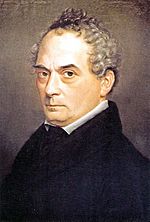Clemens Brentano facts for kids
Quick facts for kids
Clemens Brentano
|
|
|---|---|

Portrait by Emilie Linder, painted in 1835; printed in from Meyer's Encyclopedia, 1906
|
|
| Born | 9 September 1778 Ehrenbreitstein near Koblenz (today in Koblenz), Electorate of Trier, Holy Roman Empire |
| Died | 28 July 1842 (aged 63) Aschaffenburg, Germany |
| Occupation | Writer |
| Nationality | German |
| Alma mater | University of Halle |
| Period | Romantic |
| Genre | Poetry |
| Notable works | Des Knaben Wunderhorn |
| Relatives | Bettina von Arnim (sister) Christian Brentano (brother) Sophie von La Roche (grandmother) Franz Brentano (nephew) Lujo Brentano (nephew) Gisela von Arnim (niece) |
Clemens Wenzeslaus Brentano (born September 9, 1778 – died July 28, 1842) was an important German writer. He was a poet and wrote novels. He was a big part of a time in German history called Romanticism.
Contents
Early Life and Education
Clemens Brentano was born on September 9, 1778. His family was wealthy and lived in Frankfurt, Germany. His father's family came from Italy. His grandmother, Sophie von La Roche, was also a writer.
Clemens had a sister named Bettina von Arnim. She was also a writer. When she was young, she wrote letters to the famous writer Johann Wolfgang von Goethe. Later, she published these letters in a book.
Clemens studied at universities in Halle and Jena. After his studies, he lived in different cities like Heidelberg, Vienna, and Berlin. He became friends with many important writers and thinkers of his time. These included Wieland, Herder, Goethe, Friedrich Schlegel, Fichte, and Tieck.
Life as a Romantic Writer
From 1798 to 1800, Brentano lived in Jena. This city was a main center for the Romantic movement. In 1801, he moved to Göttingen. There, he became good friends with Achim von Arnim.
Brentano married writer Sophie Mereau in 1803. In 1804, he moved to Heidelberg. He worked with Arnim on two important collections: Zeitungen für Einsiedler and Des Knaben Wunderhorn. Des Knaben Wunderhorn was a collection of old German folk songs. It became very famous.
After his wife Sophie passed away in 1806, he married again in 1807. His second wife was Auguste Bussmann. From 1808 to 1818, Brentano mostly lived in Berlin. Later, from 1819 to 1824, he lived in Dülmen, Westphalia.
Later Life and Religious Work
In 1818, Brentano decided to change his life. He returned to the Catholic Church. He went to a monastery in Dülmen. He lived there quietly for several years.
While at the monastery, he became a secretary for a Catholic nun named Anne Catherine Emmerich. She was known for her religious visions. Brentano stayed with her from 1818 until she passed away in 1824. He wrote down everything she said about her visions.
After she died, he organized her writings. He published a book called The Dolorous Passion of Our Lord Jesus Christ in 1833. This book shared her visions.
Later in his life, Brentano lived in cities like Regensburg, Frankfurt, and Munich. He continued to support the Catholic faith. He also helped his brother-in-law, Ludwig Achim von Arnim, with the folk song collection Des Knaben Wunderhorn. This collection later inspired the composer Gustav Mahler to write songs.
In 1835, a Swiss painter named Emilie Linder painted a famous portrait of him. Clemens Brentano passed away in Aschaffenburg on July 28, 1842.
Literary Style and Works
Clemens Brentano was part of the Heidelberg group of German Romantic writers. His writing often used a lot of amazing and imaginative pictures. His style could be sudden and unusual.
Some of his first published works include Satiren und poetische Spiele (1800) and a story called Godwi oder Das steinerne Bild der Mutter (1801). He also wrote a musical play called Die lustigen Musikanten (1803).
His best plays are Ponce de Leon (1804), Victoria und ihre Geschwister (1817), and Die Grundung Prags (1815).
Many people loved his short stories. One of his most popular stories was Geschichte vom braven Kasperl und dem schönen Annerl (1817). This story has even been translated into English. His collection of poems, Romanzen vom Rosenkranz, was published after he died in 1852.
Today, a special award for German literature is given in his honor. It is called the Clemens Brentano prize.
Poems
- Eingang
- Frühlingsschrei eines Knechtes
- Abendständchen
- Lore Lay
- Auf dem Rhein
- Wiegenlied
- An Sophie Mereau
- Ich wollt ein Sträusslein binden
- Der Spinnerin Lied
- Aus einem kranken Herzen
- Hast du nicht mein Glück gesehen?
- Frühes Lied
- Schwanenlied
- Nachklänge Beethovenscher Musik
- Romanzen vom Rosenkranz
- Einsam will ich untergehn
- Rückblick
Religious Works
- Die Barmherzigen Schwestern in Bezug auf Armen- und Krankenpflege (Care of the Poor and Sick by the Sisters of Mercy ) (1831)
- Lehrjahre Jesu (The Formative Years of Jesus) (1822)
- Das bittere Leiden unsers Herrn Jesu Christi (The Dolorous Passion of Our Lord Jesus Christ) (1858-1860)
- Das Leben der heil. Jungfrau Maria (The Life of the Holy Virgin Mary) (1852, published after his death)
- Biographie der Anna Katharina Emmerick (Biography of Anna Katharina Emmerich) (unfinished, 1867–1870)
- Tagebuchaufzeichnungen: Geheimnisse des Alten und des Neuen Bundes: Aus den Tagebüchern des Clemens Brentano (Notes from a Diary: Secrets of the Old and New Testaments from the Diaries of Clemens Brentano)
Fairy Tales
- Die Mährchen vom Rhein
- Italienische Märchen
Images for kids
See also
 In Spanish: Clemens Brentano para niños
In Spanish: Clemens Brentano para niños


